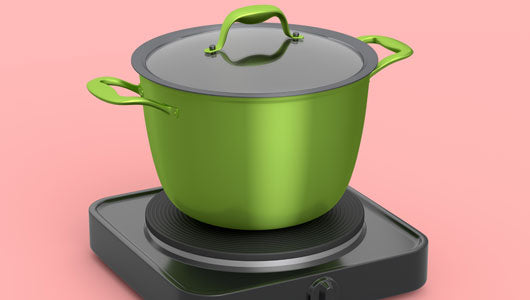
Can I Boil Sex Toys?
When you want to thoroughly sterilize your sex toys, you might decide to boil them in water to really ensure a deep clean. But which toys are safe to boil, and how do you make sure they don’t get damaged in the process?
Read on. I'll give you the full scoop on which sex toys can be boiled, how to do it safely and effectively, and why even boiling won't sterilize your toys.
Why Should You Boil Sex Toys?
Giving your sex toys a wipe-down with toy cleaner banishes most of the bacteria they may have picked up during use. Sex toy spray or mild soap and water are safe and effective ways to wash away lubricants, oils, and body fluids, and are sufficient cleaning methods — most of the time.
But what if you want to give your toys a deep clean? Maybe your dildo collection could use a spring spruce-up, or the usual quick scrub isn't cutting it for your anal toys. Or you want to share toys with a partner, and be sure they're as clean as possible before you make the swap. Enter a simple pot of boiling water.
Unlike toy cleaner and soap, boiling water kills or inactivates the majority of viruses, bacteria, and other pathogens by disrupting their essential life processes and damaging their structure.
Boiling toys helps to make them ultra-clean, safer for vaginal and oral play after anal use, and more hygienic to enjoy with other people. Boiling can also help to remove odors from silicone toys, including butt plugs and dildos.
Learn more: Is My Butt Plug Safe?
Does Boiling Sterilize Sex Toys?
Boiling does not sterilize sex toys, or any object. It's more accurate to describe a boiled toy as pasteurized. What's the difference between the various cleaning methods?
- Sanitizing reduces the amount of bacteria on surfaces to acceptable levels. Toy cleaners, UV light cleaners, and soap and water can all help to sanitize sex toys
- Sterilizing kills all microorganisms on surfaces. Sterilizing usually requires an autoclave, infrared radiation, or a dry heat cabinet, such as those used for surgical instruments. Boiling is not a sterilization method
- Disinfecting kills harmful bacteria and viruses on surfaces. Disinfectants often come in spray or chemical form
- Pasteurizing uses heat to kill or inactivate microorganisms that are harmful to humans. Boiling a sex toy is a way to pasteurize it
Which Sex Toys Are Safe To Boil?
While the list of sex toy materials is long, the list of materials that are safe to boil is short! In fact, it's only two items long. Let's take a look at the toy materials that are safe to boil as well as the toy materials that aren't.
Safe To Boil
Silicone toys without a motor. Non-motorized silicone toys like dildos, butt plugs, and cock rings are safe to boil. Note the words non-motorized. That means that if it vibrates, switches on, has a remote, or can be charged, it's not to safe to boil, even if it's made from silicone.
Because of their smooth texture, silicone toys are less likely to get scuffed. Just make sure the toy is 100% pure silicone before you boil it. If it’s mixed with plasticizers or other softening materials, hot water can damage or destroy it.
Learn more: What Is Body-Safe Silicone?
Stainless steel without a motor. Non-motorized stainless steel toys like wands and butt plugs are safe to boil. If a stainless steel toy has a motor, vibrates, or comes with a charging cable, it's not safe to boil.
Non-motorized stainless steel toys are durable and equipped to withstand boiling temperatures. Because stainless steel is a hard material, it can knock around quite a bit when submerged in a rolling boil. To prevent scuffing, you can use a silicone pot insert such as a pasta drainer to protect your toy from the sides of the pot.
One caveat about boiling stainless steel: make sure your toy is made from 100% stainless steel and not a composite metal that could rust or flake when exposed to high temperatures. Knockoff toys made from a metal alloy may be less expensive, but they also don't behave like genuine, high-grade stainless steel. Many of these toys aren't safe to use either, and should not be put in or on the body.
Learn more: How To Use A Stainless Steel Sex Toy
Not Safe To Boil
TPE/TPR. TPE is another porous material that should be kept away from high temperatures. TPE can melt on a hot day in a room without air conditioning, so you can imagine what boiling might do.
Learn more: Are TPE Sex Toys Safe?
Glass. Many glass toys are made from borosilicate glass, which is the same material used to make glass baking dishes. But glass dishes have been known to crack apart when they go quickly from a cold environment to a hot one, or vice versa. Some people boil glass toys by warming them up gradually to prevent thermal shock.
My take? It’s better to be safe than have a shattered toy. Glass can also chip unless protected from the pot's surface while boiling.
Learn more: Complete Guide To Glass Sex Toys
PVC. Boiling PVC sex toys is a hard no. PVC is a porous material that contains plasticizers to soften it. PVC will melt when exposed to high heat.
ABS plastic. Another no. Though it's body-safe, ABS plastic is too soft and destructible to handle boiling water, or very high temperatures in general.
Learn more: Are ABS Plastic Sex Toys Safe?
Is your toy made from a material that isn't safe to boil? Remember, boiling isn’t the only way to give your toys a deep clean! You can also use a UV sanitizing system to get the job done.
How Do You Boil A Sex Toy?
It’s important to boil your silicone and stainless steel sex toys the right way to avoid damaging them. Before you bring your toy to a rolling boil, here are some safety guidelines to keep in mind.
Do:
- Wipe it down with toy cleaner first. Remove all bodily fluids, lube, oils, and dust before boiling
- Use plain water without the addition of herbs or cleaners that could damage your toy
- Put plenty of water in the pot. Make sure the toy is fully covered on all sides
- Let it boil by itself. Boiling several toys in the same pot can cause scuff marks or scratches
- Let it boil for 5-10 minutes to kill the majority of microorganisms on the toy's surface
- Remove it with tongs and let it air dry
Don’t :
- Boil stainless steel without a buffer like a clean washcloth or silicone pot insert to protect the material as it moves around
- Touch stainless steel for at least 30 minutes after removing it from the water. This material retains heat and can cause burns
- Run a just-boiled sex toy under cold water. A quick and dramatic change in temperature can damage toy materials
- Boil anything with a battery or electronic parts, regardless of what it’s made from
For detailed info on how to clean sex toys of all kinds, check out our complete guide: How To Clean Your Sex Toys
